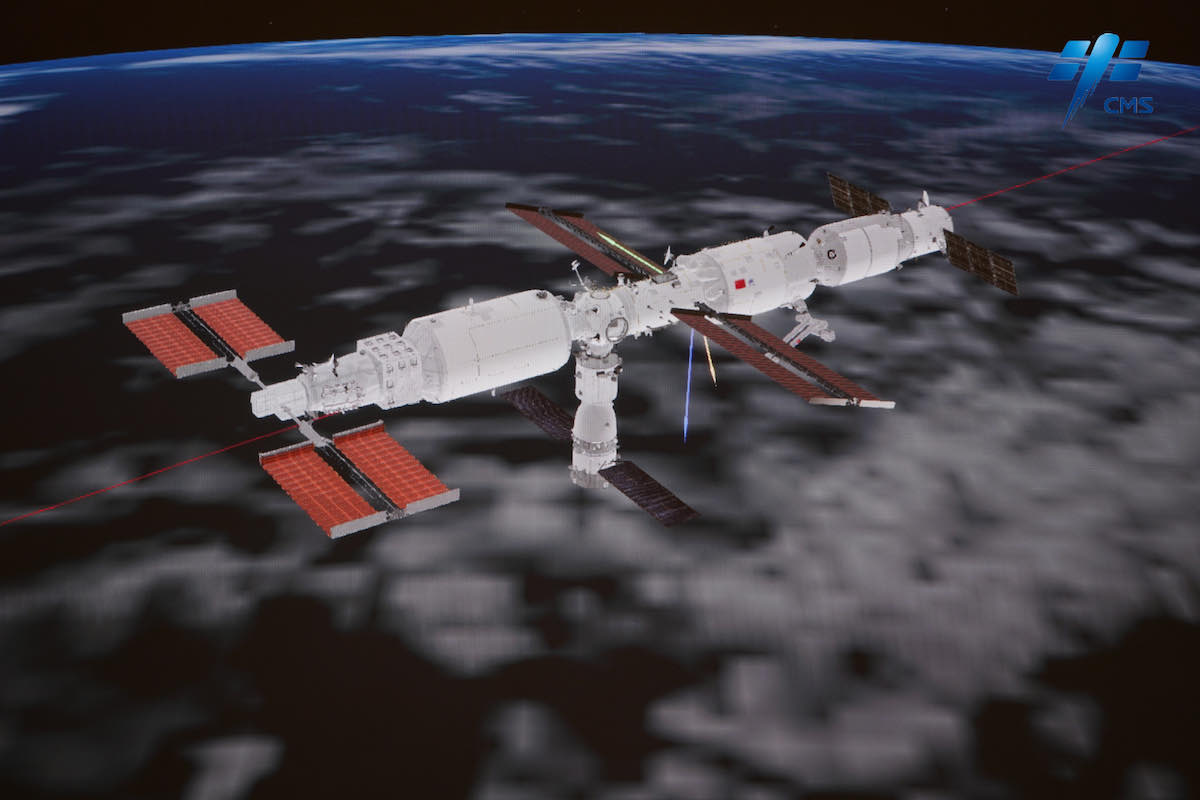
China’s Tiangong space station received a new room Sunday with the docking of the Wentian laboratory module, a half-day after launching on a heavy-lift Long March 5B rocket. The three-person crew on the Chinese space station later opened hatches and floated inside the new science module for the first time.
The Wentian module docked with the forward port of the Tianhe core module at 3:13 p.m. EDT (1913 GMT) Sunday as the vehicles flew about 240 miles (385 kilometers) over the Indian Ocean west of Australia.
Chinese commander Chen Dong on the Tiangong station opened hatches and entered the Wentian module at 10:03 p.m. EDT Sunday (0203 GMT Monday). Crewmates Liu Yang and Cai Xuzhe joined Chen inside the Wentian module for inspections before downlinking a message to Chinese ground controllers in Beijing.
The astronauts are about one month into a six-month expedition on the Tiangong space station. They arrived last month on China’s Shenzhou 14 spacecraft and are scheduled to return to Earth in December.
The Wentian module launched at 2:22 a.m. EDT (0622 GMT; 2:22 p.m. Beijing time) Sunday aboard a heavy-lift Long March 5B rocket from the Wenchang space center on Hainan Island, China’s southern most province. The powerful single-stage launcher, assisted by four strap-on boosters, deployed the more than 50,000-pound (23-metric ton) Wentian module into orbit about eight minutes later.
The Long March 5B’s core stage remained in a low orbit after the launch, and is expected to fall back into the atmosphere for an unguided re-entry in the coming weeks.
The Wentian spacecraft partially extended its solar panels, as planned, and completed a series of rocket burns to fine-tune its approach to the Tiangong space station, completing an automated rendezvous and docking about 13 hours after launch.

Wentian, which means “quest for the heavens,” will later be relocated to its permanent position on a lateral port of the Tianhe module. The 33-foot-long (10-meter) robotic arm on the core module will move Wentian to its new location. Another large module, named Mengtian, is scheduled for launch in October to complete the initial construction of the Tiangong station.
In their final locations, the three modules will give the space station a “T” shape, with docking ports to receive visiting crew and cargo ships. The fully-assembled Tiangong complex will be about one-sixth the size of the International Space Station, but still the second-largest spacecraft in low Earth orbit.
The Wentian module, measuring about 58.7 feet (17.9 meters) long, is fitted with 22 external mounting platforms to host science instruments and unpressurized experiments in the vacuum of space. There are accommodations for up to eight life science and biological research racks inside the module’s pressurized volume, and the new module will add an airlock to support spacewalks outside the Tiangong space station.
Now docked at the Tiangong station, the massive module will fully unfurl its solar panels to a span of about 180 feet (55 meters) tip-to-tip to produce its own electricity. The solar arrays on the Wentian module are the largest ever flown on a Chinese spacecraft.
The Wentian module also carries a small 16-foot (5-meter) robotic arm designed for more precise movements than the larger 33-foot arm on the outside of the Tianhe core module. Wentian’s arm, which can be combined with the Tianhe arm for a longer reach, will primarily be used to transfer experiments and other hardware outside the station.
The crew on the complex will stage two or three spacewalks from the Wentian module in the next few months.
“The Wentian experimental cabin is mainly for space life science research, equipped with experimental cabinets such as life ecology, biotechnology, and variable gravity science,” said Lin Xiqiang, deputy director of the China Manned Space Agency, in a press briefing last month.
Wentian’s experiments will support research into genetics, aging, organs, tissues, and cells. The variable gravity experiment rack can generate accelerations between a hundredth the pull of Earth’s gravity up to 2g, supporting comparative studies under different gravity conditions, according to the China Manned Space Agency.

The Wentian module also has three crew sleep cabins and a bathroom, doubling crew capacity provided by the Tianhe core module.
When complete, the space station will support a permanent presence of three astronauts, and a crew of six people for short durations. The next crew to launch to the Tiangong station later this year will arrive before the departure of the current team of three astronauts, temporarily increasing the crew size to six for the first time.
The China Manned Space Agency says the Wentian module has the capability to control the entire space station assembly, and can be used as a backup to the Tianhe core module to manage the complex.
Email the author.
Follow Stephen Clark on Twitter: @StephenClark1.
from Spaceflight Now https://ift.tt/NgMUknu
via World Space Info







0 comments:
Post a Comment